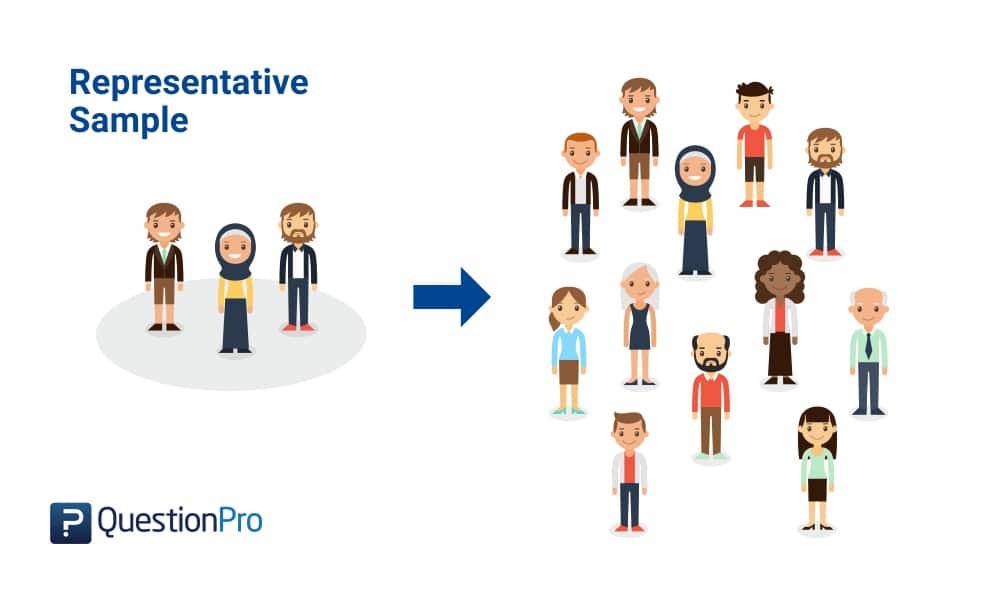
What is a representative sample?
Representative sample definition: A representative sample is defined as a small quantity or a subset of something larger. It represents the same properties and proportions like that of a larger population.
For example, consider a brand that is about to launch a new product in a US city. It will be practically impossible to send a survey to collect insights into the product’s features from every person in the city. Therefore, researchers collect a small sample of people who will represent the city’s population, and a survey can be deployed to them to manage their feedback on the product. This sample is called a representative sample.
A representative sample could be people or even chemical substances in scientific studies that can be tested in a laboratory to analyze the result of any particular chemical reaction. However, in this blog, we will concentrate on people and understand the importance of a representative population sample in market research and other helpful aspects is.
Why must you use a representative sample in research?
A representative sample allows researchers to abstract the collected information to a larger population. Most market research and psychological studies are unsuitable in terms of time, money, and resources to collect data on everyone. It is practically impossible to collect data from each person, especially for a large population such as an entire country.
The good news is, “you don’t need to do it!”. What is more important here is to get a good representative sample, so that the vast majority of your time and energy will go into getting responses from a small group of people who will represent a larger population.
Time and again, research studies have employed a smaller group of people to conduct studies, collect data, and analyze the results. Let us understand the importance of a representative sample for significant research studies.
LEARN ABOUT: Survey Sampling
Importance of a representative sample for practical research studies
- A representative sample will work in your favor to carry out successful market research. Can you imagine having to interview all the people in a country or even a city? It would sound the most impractical plan, be too complicated, and take a long time.
- A representative sample is a small number of people who reflect a more extensive group as accurately as possible. Then we can apply, for example, an online survey to a sample of the population looking for it to be the most representative of our target population.
- We will not have better results if, for example, we send a survey without taking representativeness into account, and we do not know who answers it and if the results represent the opinion of our target audience.
- If we do not have representativeness, indeed, we will have data that will not serve us at all. We must guarantee that the sample carries the characteristics that matter to us for investigation.
- Take into consideration that we will always have a bias in the sample because there will always be people who will not answer the survey because of various reasons or answer it incompletely. In this case, we cannot fully obtain the data that we require. Now regarding the sample size, the larger the sample size determination, it is more likely to represent the broader population closely.
- A large representative sample gives us greater certainty that the people included are the ones we need, and we also reduce any possible bias. Therefore, if we want to avoid inaccuracy in our surveys, we must have representative and balanced samples.
If you want, you can also learn about Selection Bias through our blog.
How to build a representative sample
Researchers use two methods to build representative samples – Probability sampling and non-probability sampling
1. Probability sampling: Probability sampling is a technique in which a researcher chooses a sample from a larger population using a method based on the probability theory. For a participant to be considered a probability sample, he/she must be selected using a random selection.
If we will use probability sampling to obtain a representative sample, then simple random sampling is the best choice. The sample choice is made at random, which guarantees that each member of the population will have the same probability of selection and inclusion in the sample group.
2. Non-probability sampling: Non-probability sampling is a sampling technique in which the researcher selects samples based on the researcher’s subjective judgment rather than random selection. In non-probability sampling, not all population members have a chance of participating in the study, unlike probability sampling, where each member of the population has a known chance of being selected.
LEARN ABOUT: Sampling Frame
Knowing the selected sample’s demographic characteristics will undoubtedly help limit the profile of the desired sample and define the variables that interest us, such as gender, age, place of residence, etc. By knowing these criteria, before obtaining the information, we can have the control to create a representative sample that is efficient. We must avoid having a sample that does not reflect the target population. The idea is to have the most accurate data possible for our project’s success.
LEARN MORE: Population vs Sample
Avoid sampling errors for better representation
When a sample is not representative, we will have a sampling error known as the margin of error. If we want to have a representative sample of 100 employees, we must choose a similar number of men and women. For example, if we have a sample inclined to a specific genre, then we will have an error in the sample.
The sample size determination is essential, but it does not guarantee that it accurately represents the population that we need. More than size, representativeness is related to the sampling bias frame, that is, to the list from which people are selected, for example, part of a survey. Therefore, we must take care that people from our target audience are included in that list to say that it is a representative sample.
Example of a representative sample
A group of citizens representing the whole country is designated as a nationally representative sample. Researchers use it to reflect and project the national reality. It can be preferences of any kind, behavior, or socio-demographic profiles.
At its best, the representative sample will give the impression of being the total population, regardless of its looks. The numbers of men vs. women must match the national proportions, the percentage in each age group or each region will exactly match the population, etc. In non-demographic measures (such as product ownership or psychographic segmentation), the sample must match the population.
Let’s take the example of age: if the researcher sets quotas at 16 to 34, 35 to 54, or greater than 55, the sample will be represented within these proportions. But if he/she analyzes age ranges 16 to 20, 21 a 30, 31 to 40, etc., there is no guarantee that the sample will remain correct.
The extent to which quota control in a sample is possible depends on the sample’s size and the reference data available in a survey. Six periods of age, two genera, and 15 regions create a grid of 180 cells. If the sample size is only 100, it is not possible to fill all the cells. Even with a larger sample size, a section may require only half a person, and therefore it will not have the data in it.
Weighting can be used to make a sample more representative. As an alternative to interlaced cells, the quota cells can be structured independently. The disadvantage here is that there may be considerable “gaps” in the sample. If all the youth are men, for example, it will not be possible to use the weighting to correct the gaps.







